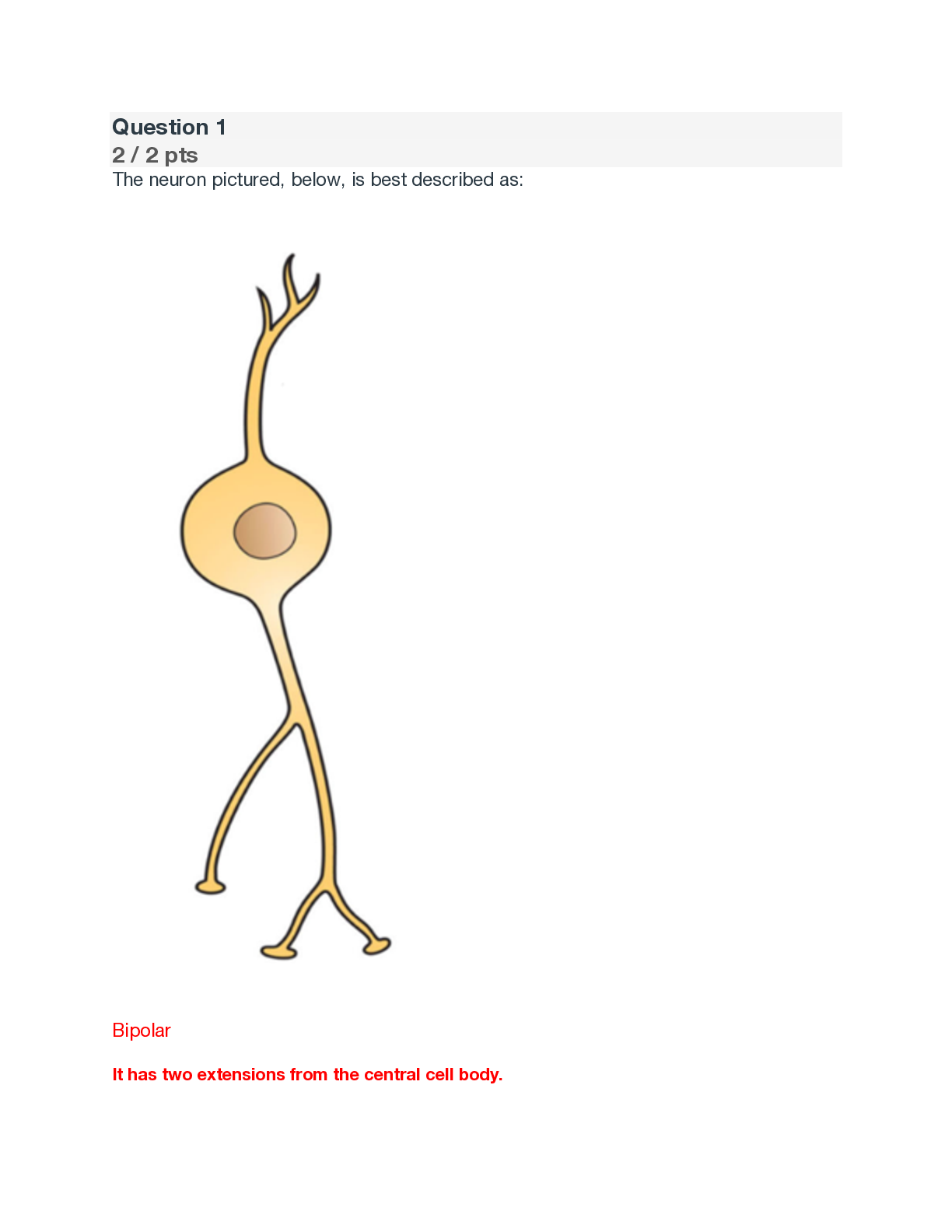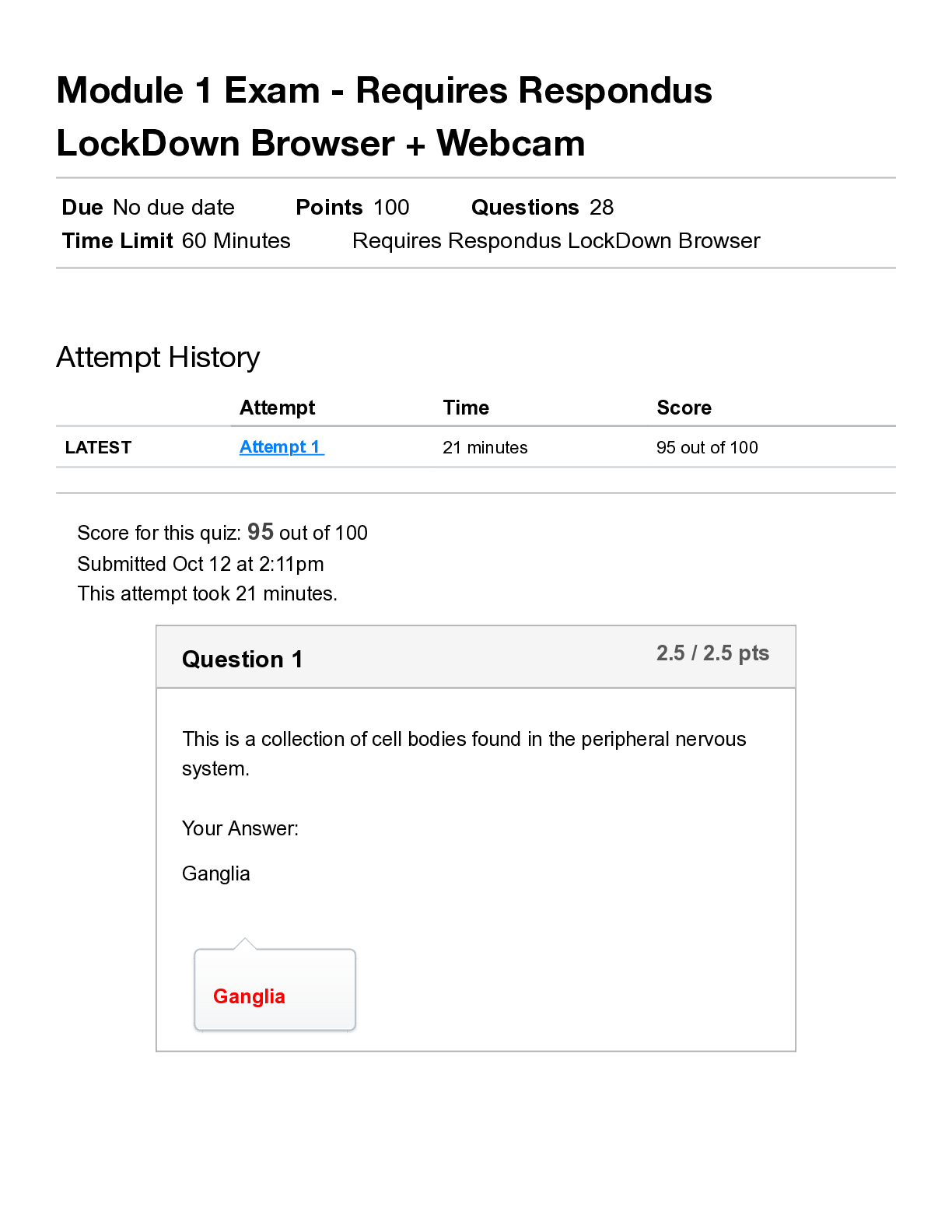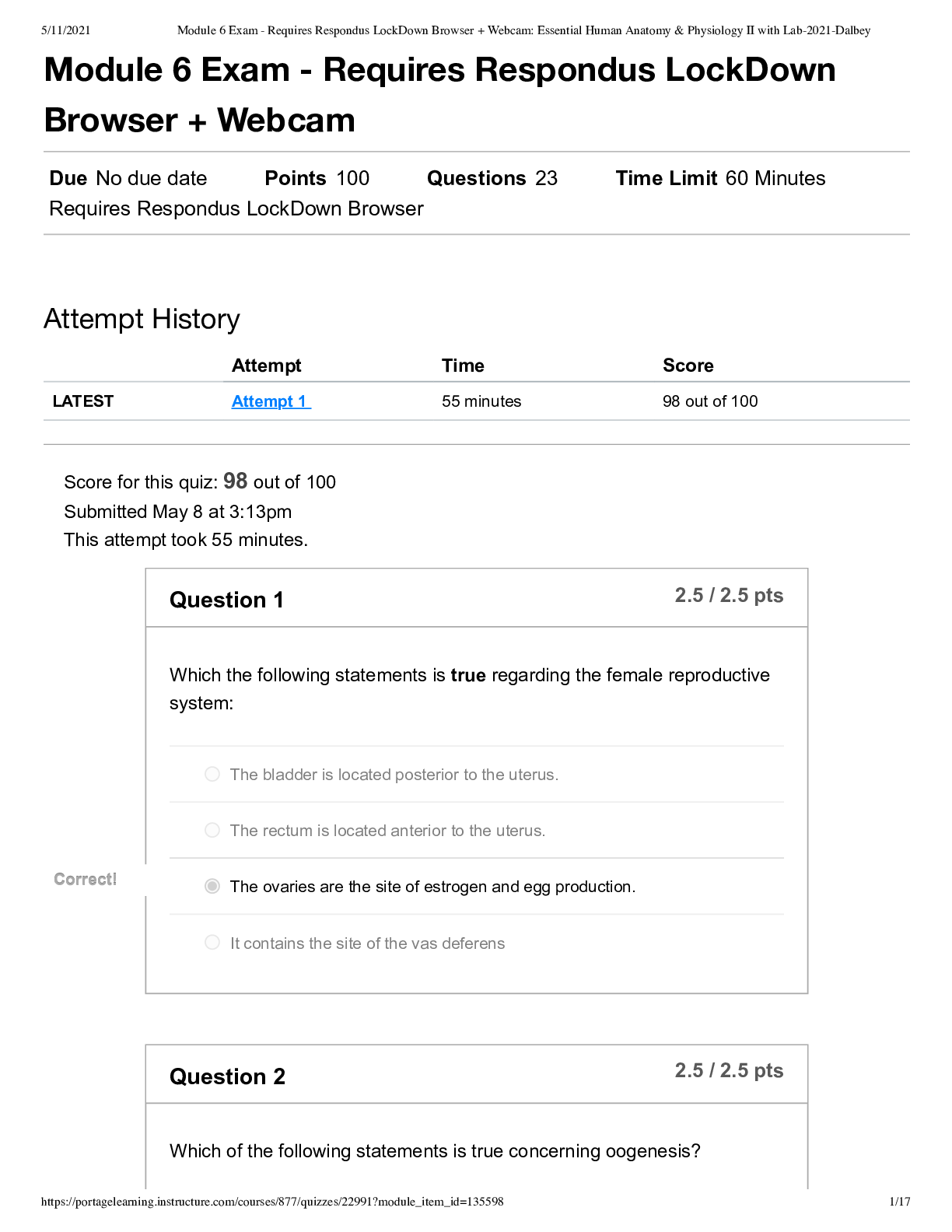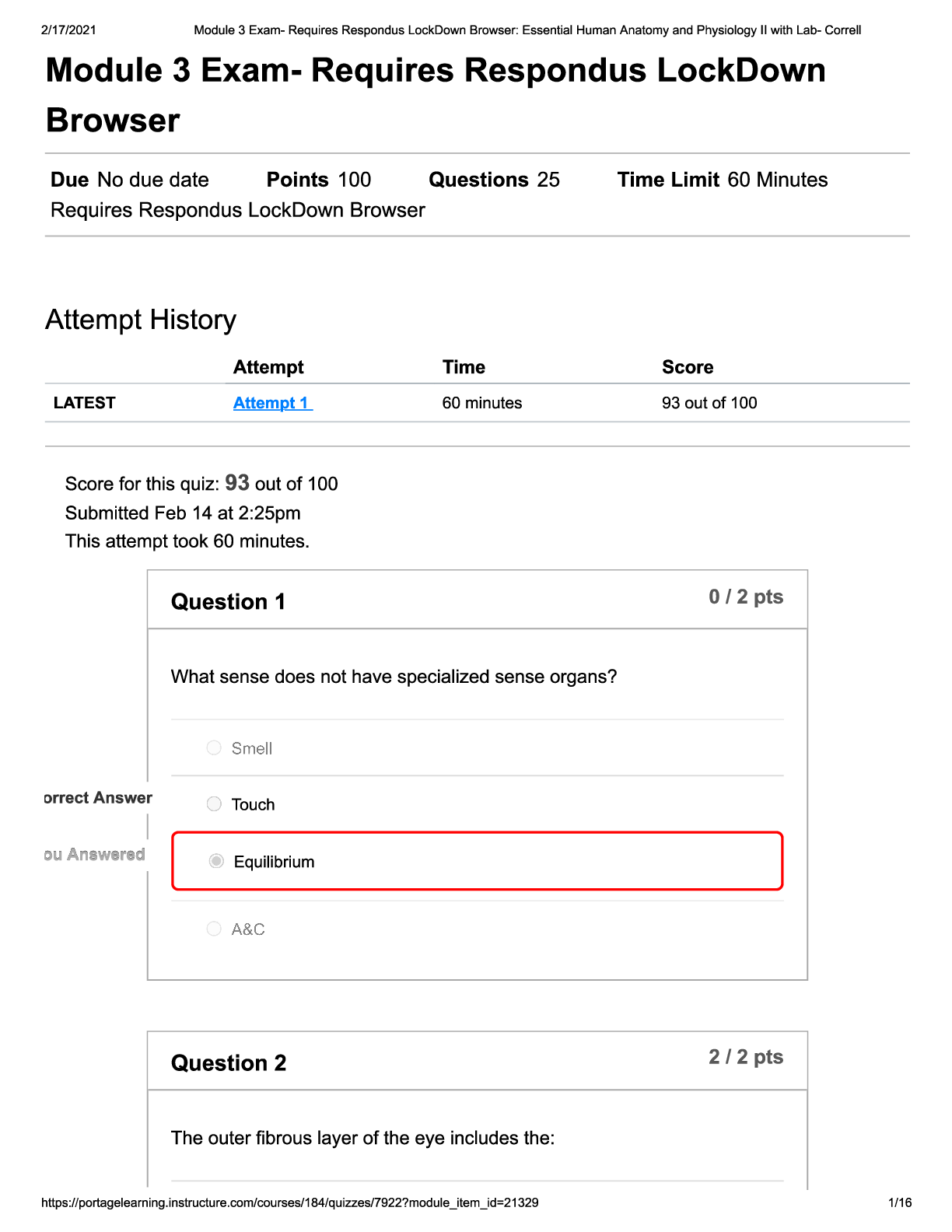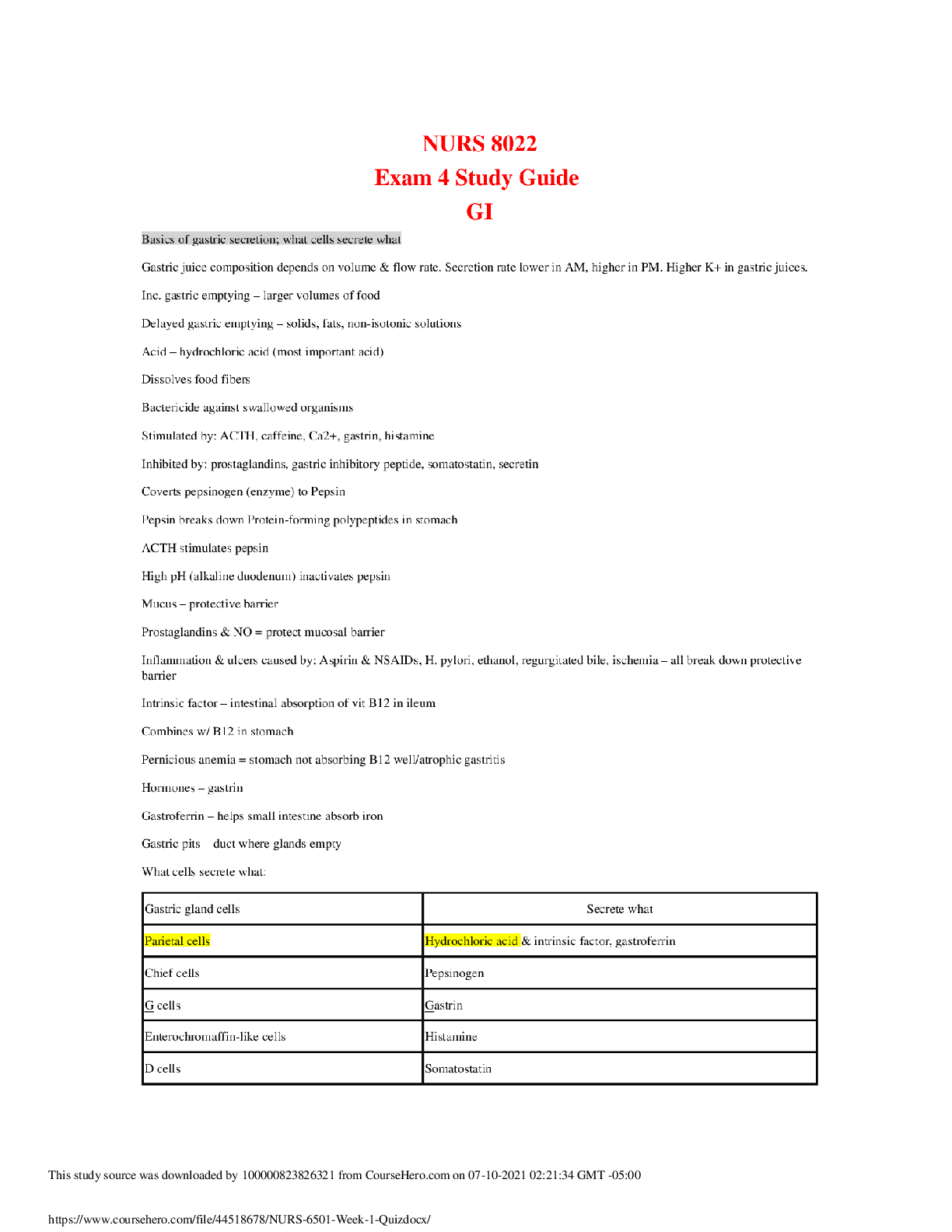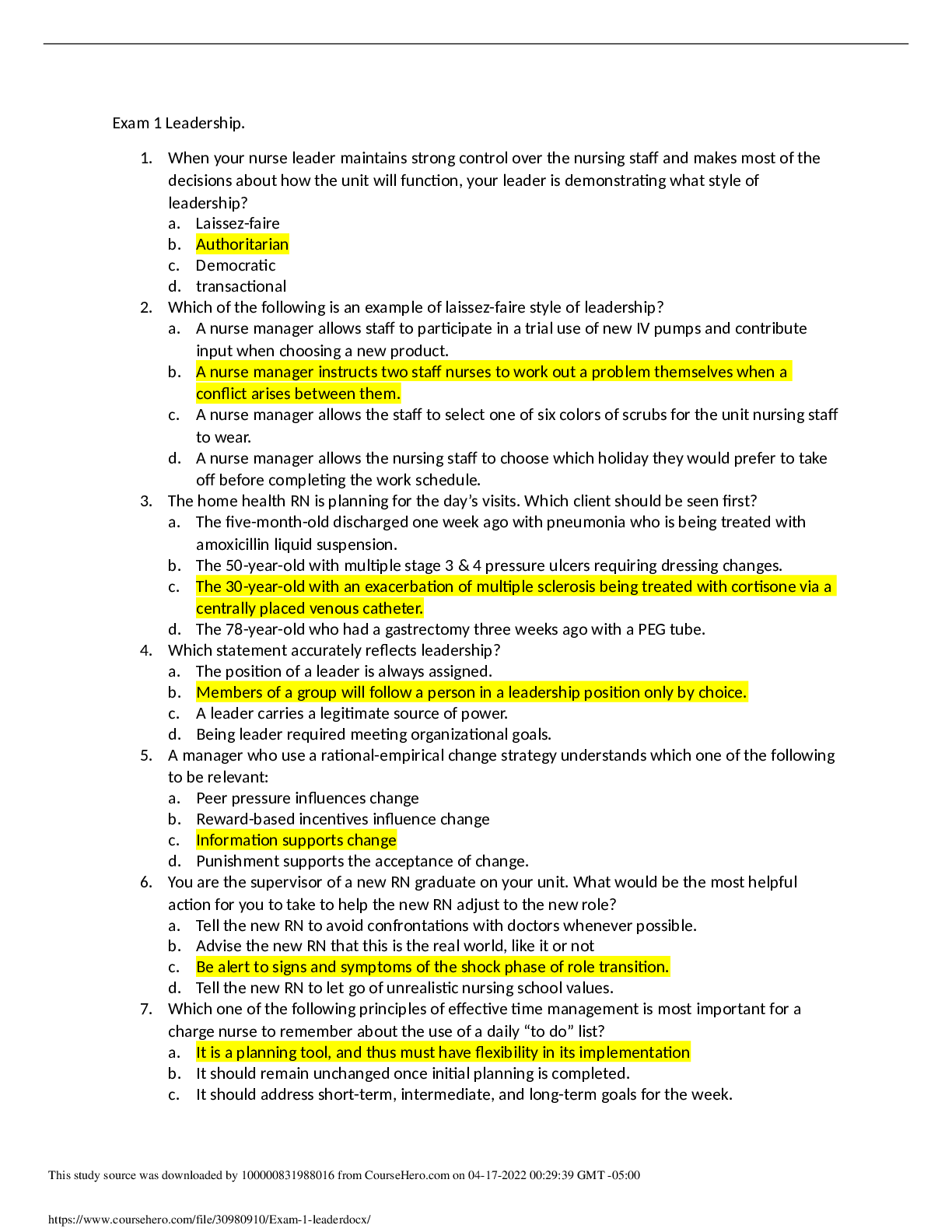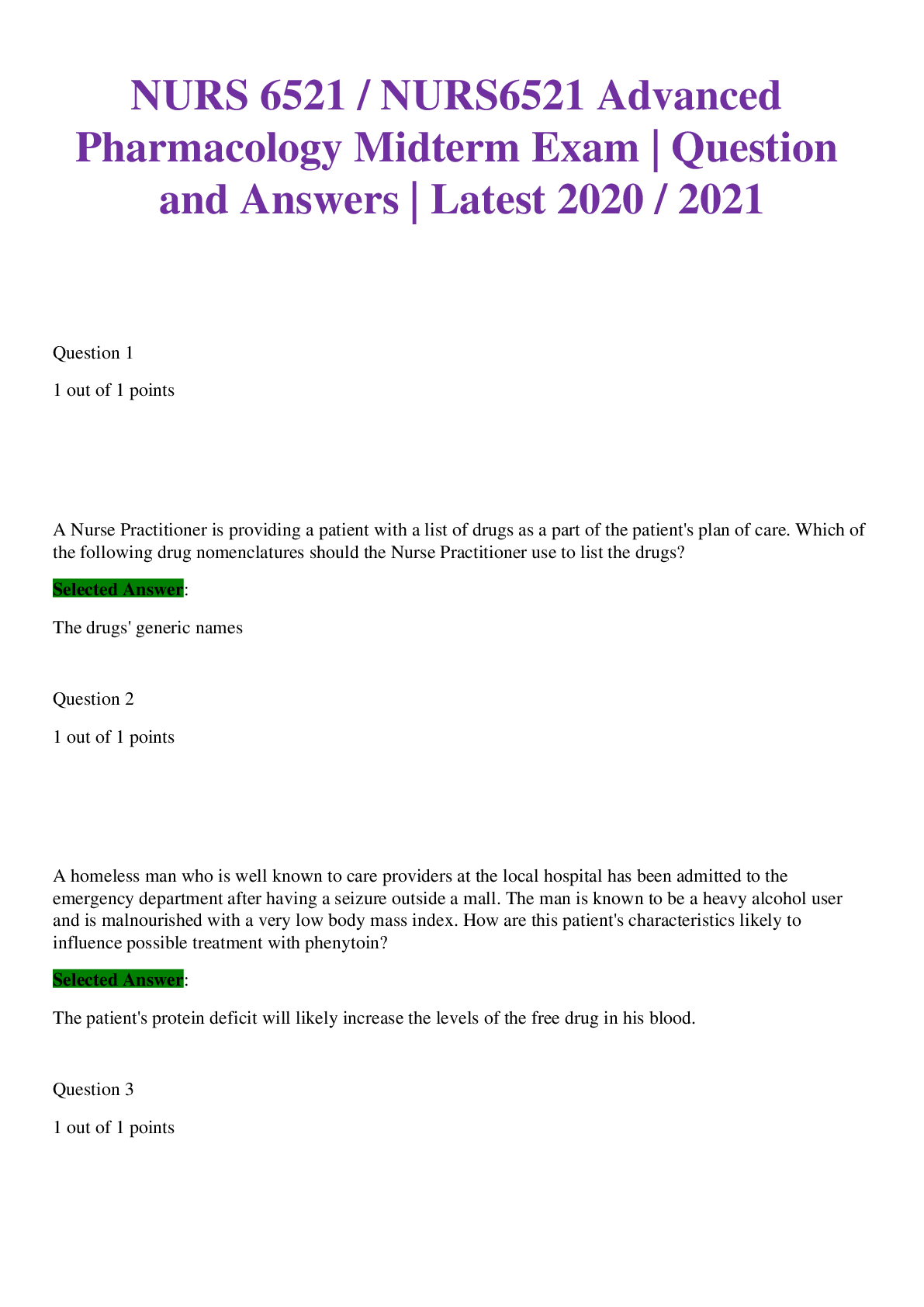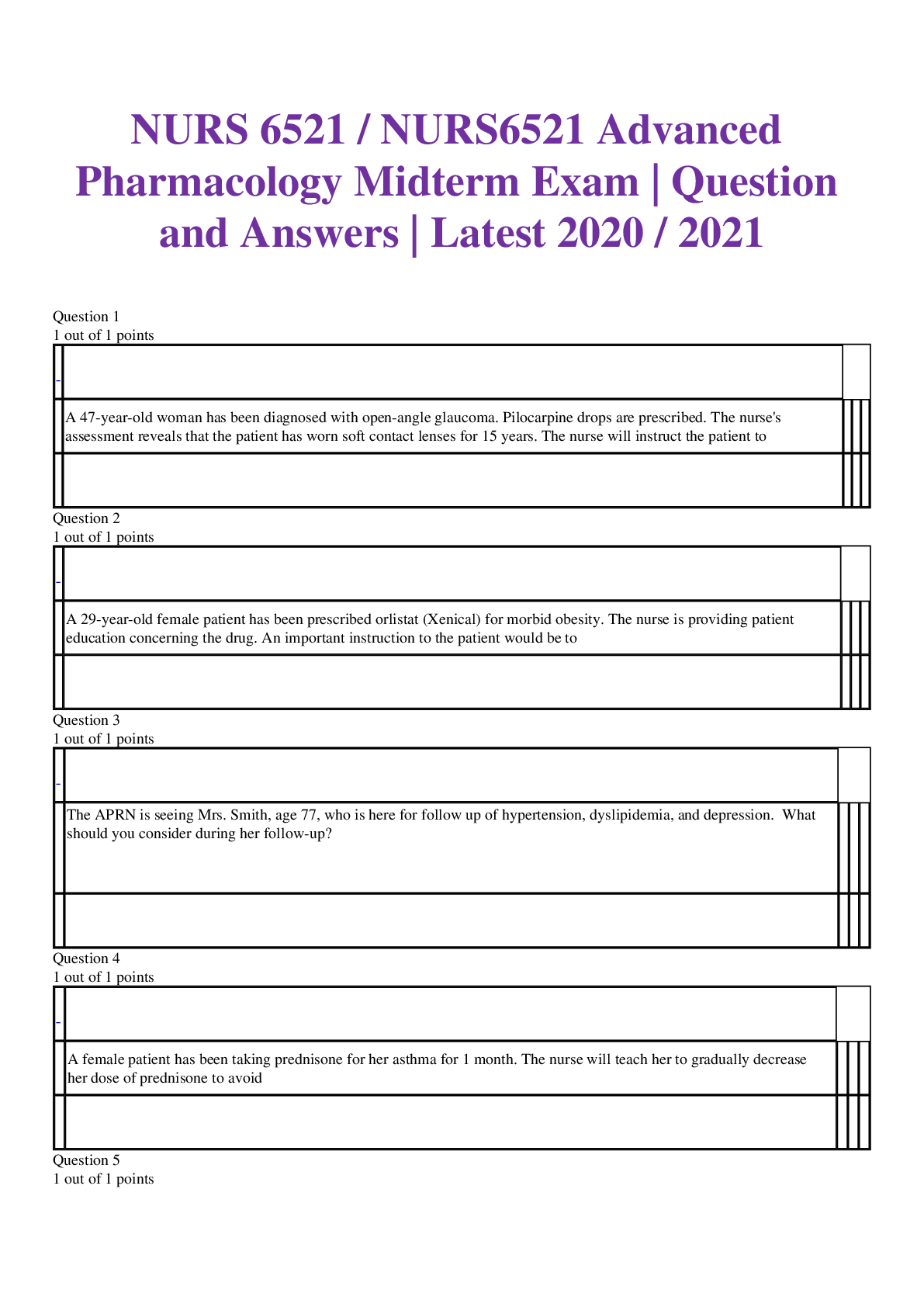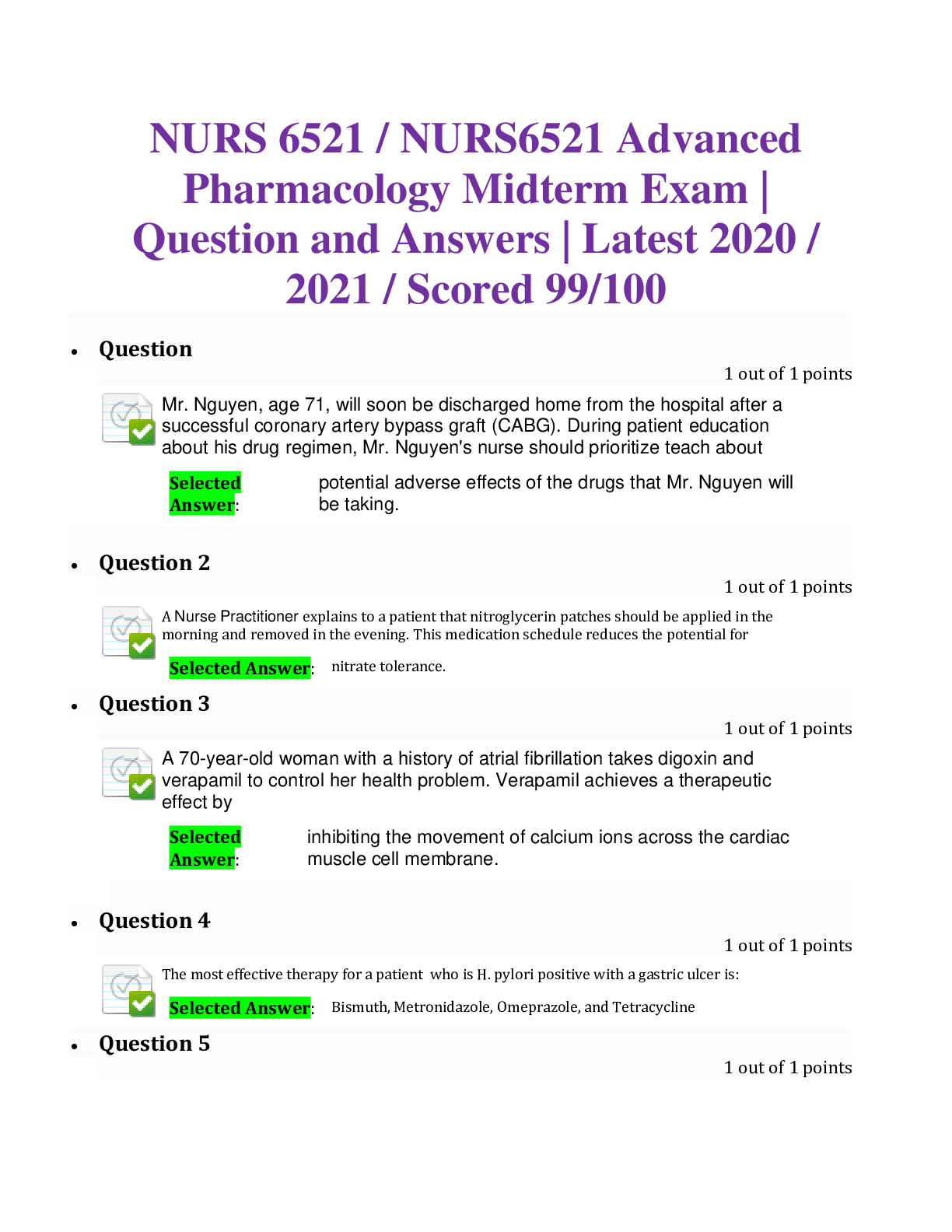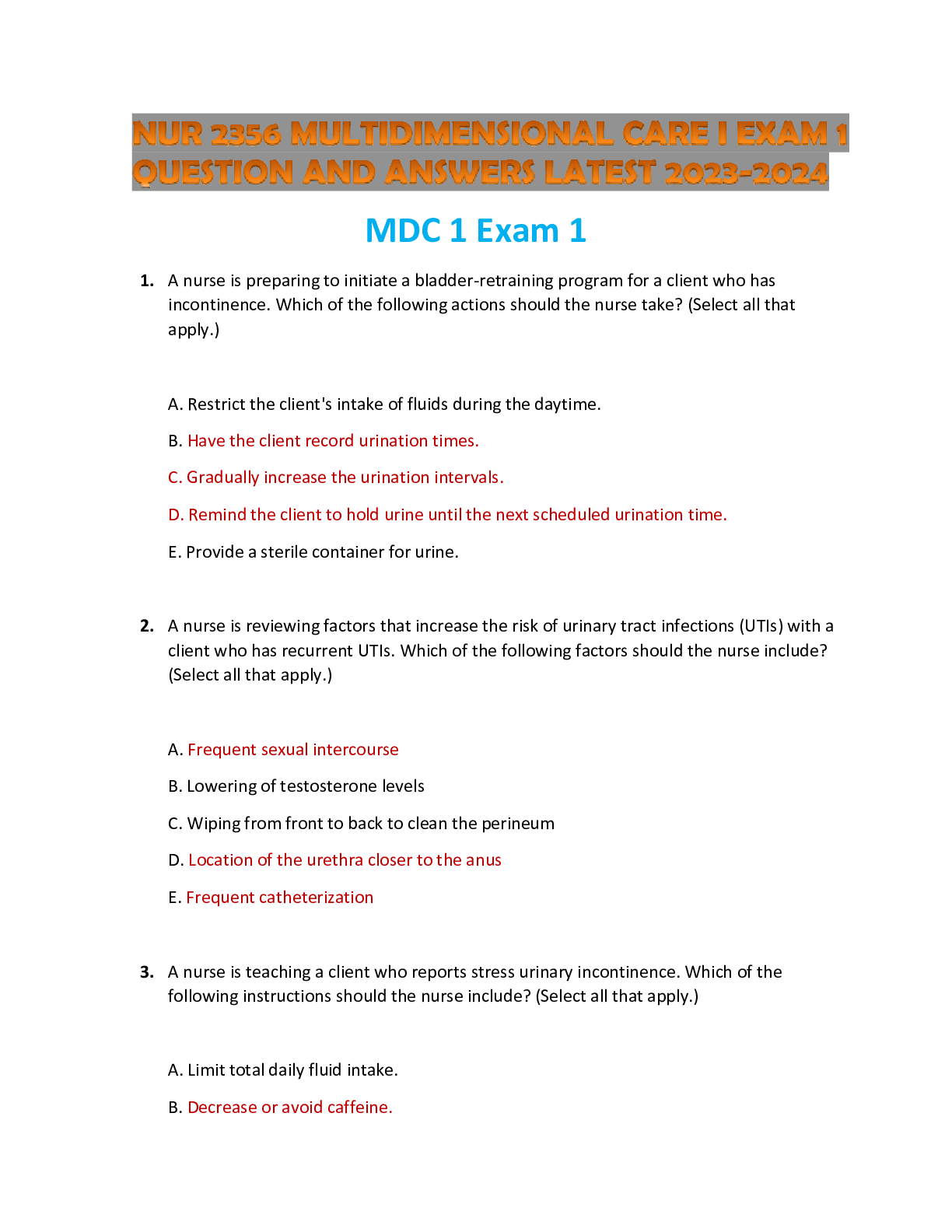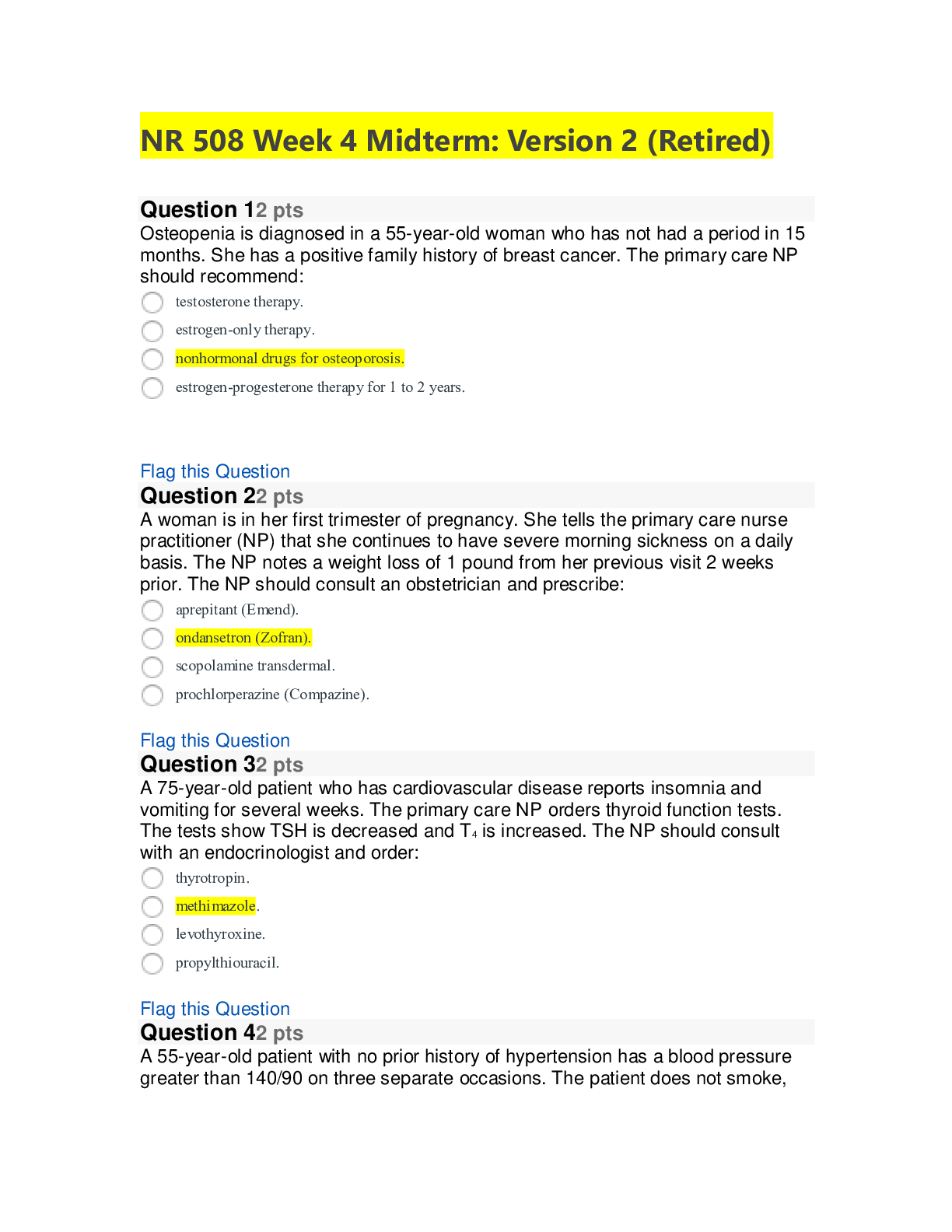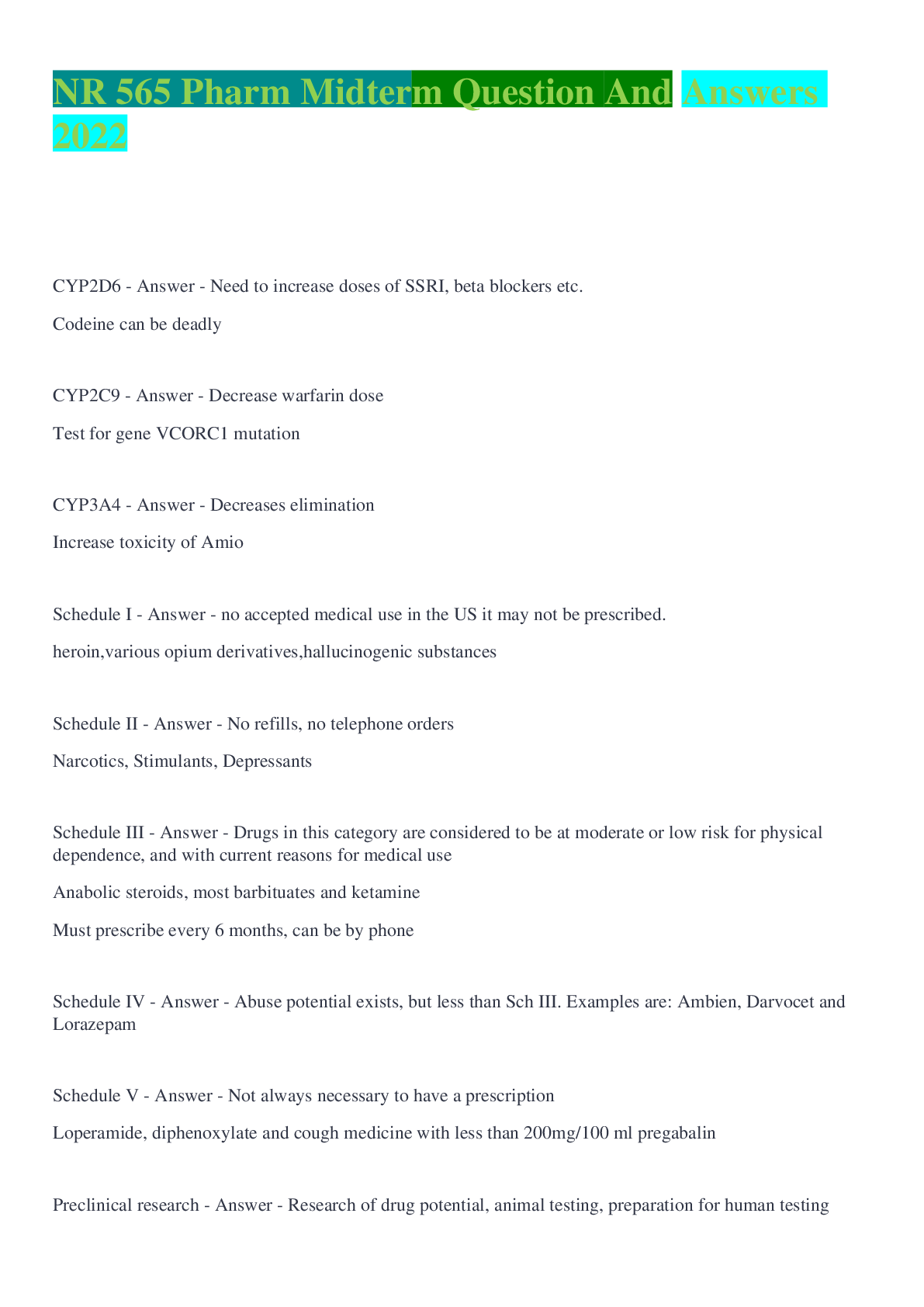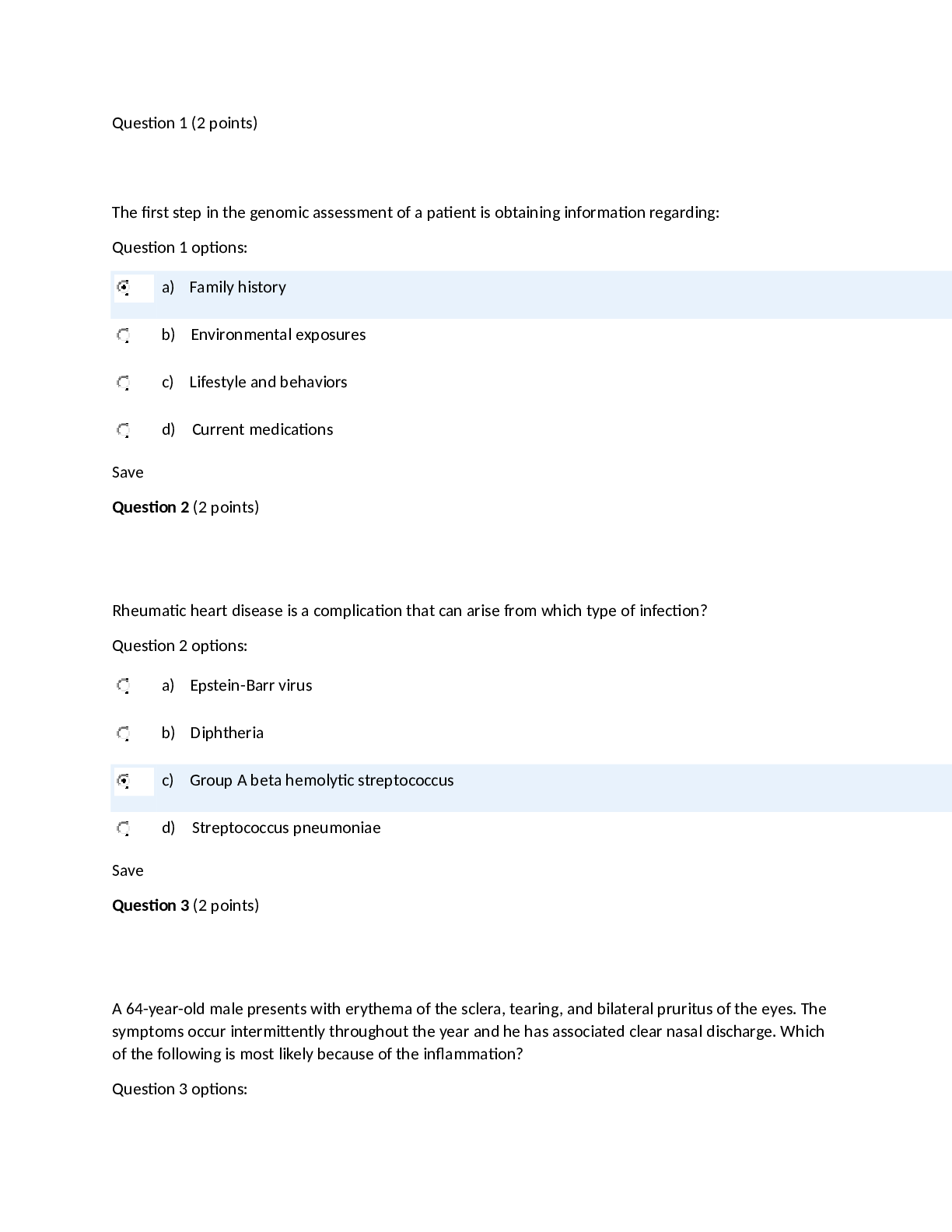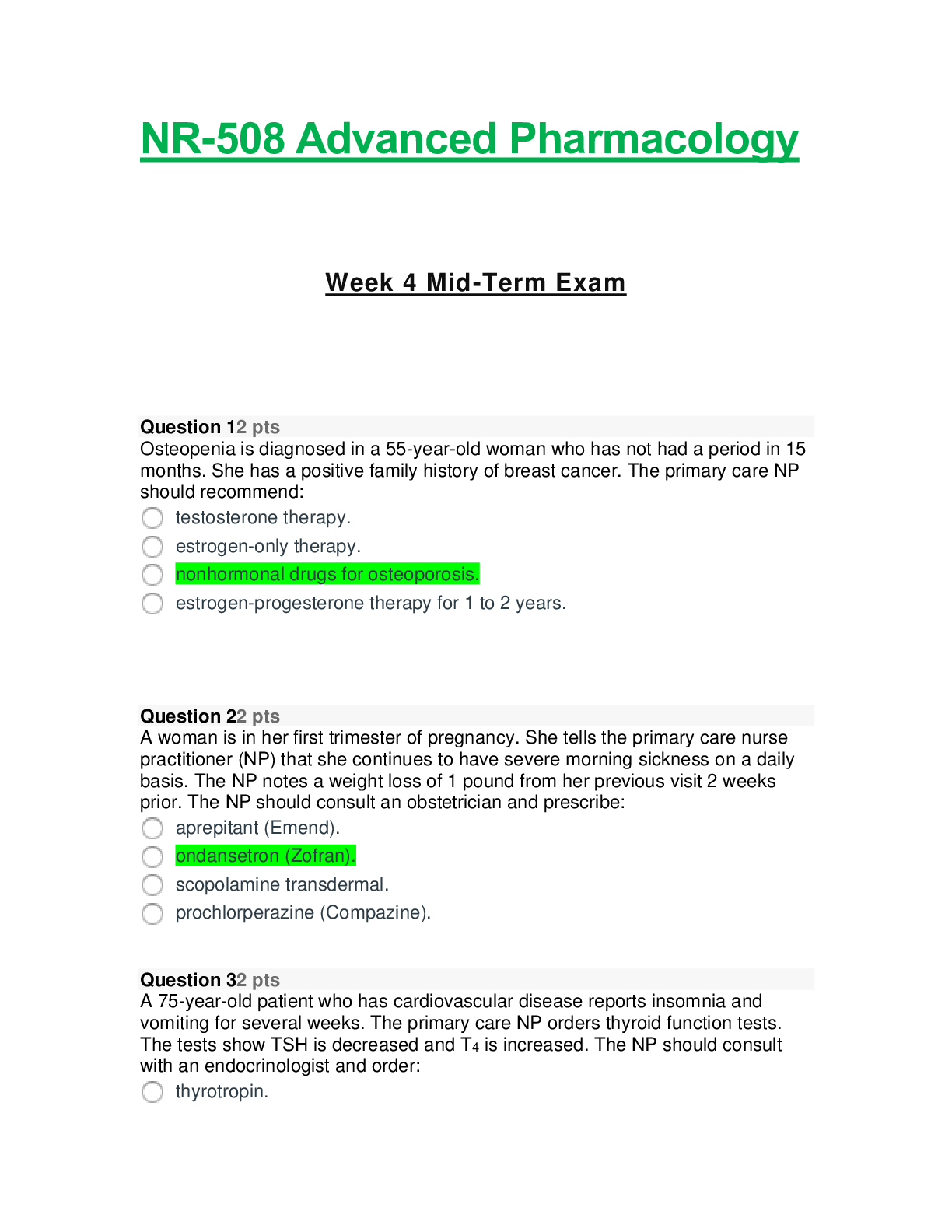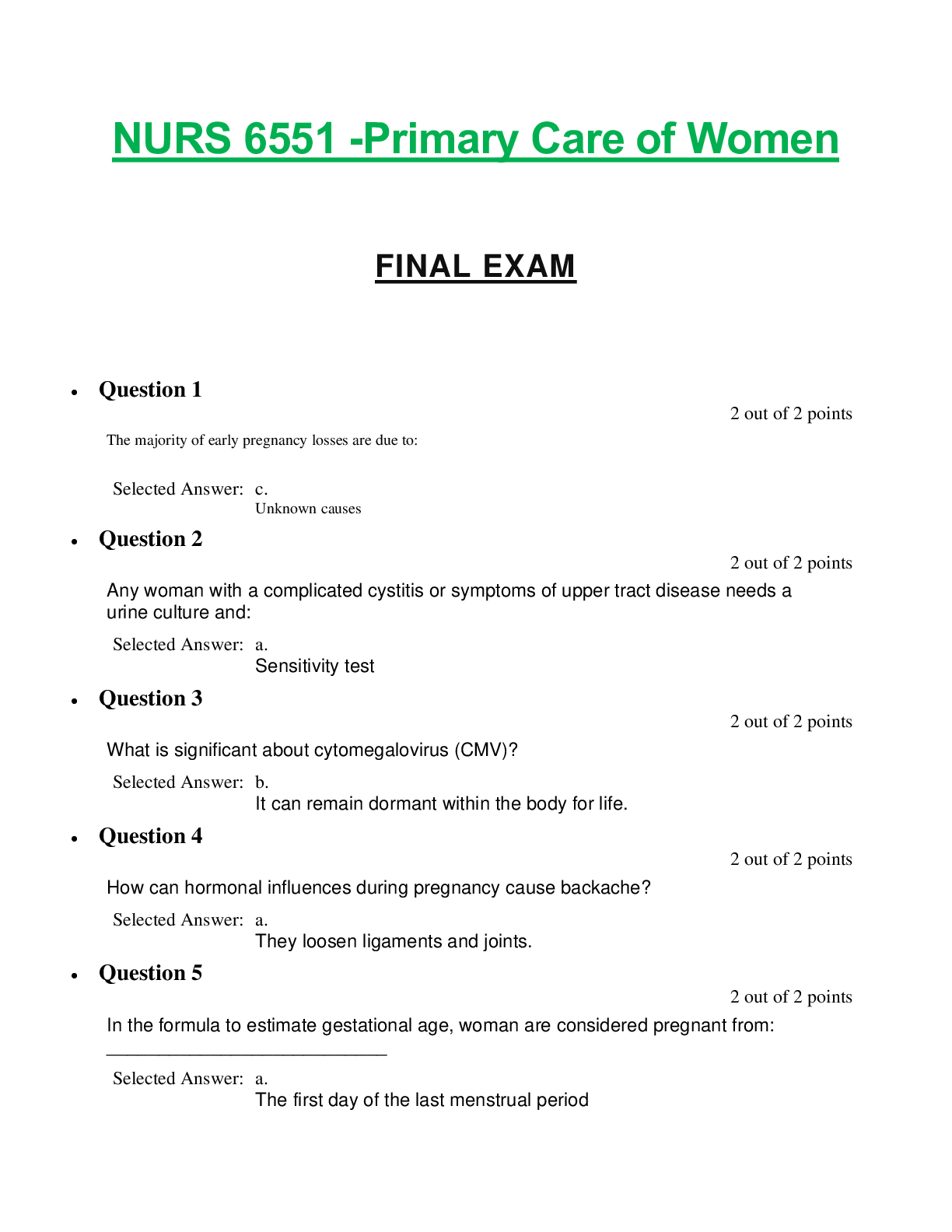Health Care > EXAM > NURS 6640 FINAL EXAM 2- QUESTION AND ANSWERS (All)
NURS 6640 FINAL EXAM 2- QUESTION AND ANSWERS
Document Content and Description Below
A PMHNP is using interpersonal psychotherapy with a 40-year-old patient having relationship problems with his extended family. The patient shares that he has been using the strategies they identified ... to reduce his distress, but they have not been helping. He is frustrated and is considering stopping treatment. What would be an appropriate step by the PMHNP? The PMHNP has been providing supportive psychodynamic psychotherapy to a patient and is nearing the termination stage. The PMHNP will use which criteria for determining that the patient is ready for termination? A PMHNP is using Gestalt therapy to communicate with a 42-year-old patient who is upset with her mother. She says, “I want to tell her how hurt I feel when she doesn’t call me, but I don’t want to upset her.” What technique can the PMHNP use to help Sasha express herself? The PMHNP is caring for an older patient with major depressive disorder, seasonal pattern. The patient has been resolute about not taking medication to manage the depression brought on by his illness, stating that it is against his yogic lifestyle. In addition to psychotherapy, what can the PMHNP suggest to this patient? A PMHNP is assessing a 60-year-old patient named Carlos. He has severe PTSD and mild substance abuse issues. The most appropriate setting to treat Carlos would be a _________. The PMHNP is caring for a patient who is histrionic. Using the supportive psychodynamic therapy model, what is the best statement made by the PMHNP? The PMHNP is meeting with a patient who has been diagnosed with depression. The patient is having trouble adjusting to her new job and hasn’t made any new friends there. What would an appropriate response be by the PMHNP using the interpersonal psychotherapy approach? The PMHNP is initiating a plan of care for a patient who requires comprehensive psychotherapy to manage his depression and mood disorder. Throughout the initial sessions, the patient reports feeling as though he cannot be helped. The PMHNP is concerned about premature termination initiated by the patient. What strategy can the PMHNP employ to prevent or reduce premature termination? A PMHNP is assessing a 40-year-old patient named Sarah who has a severe cocaine addiction and mild depression. Using the four-quadrant model, what would be the most appropriate setting to help the patient? A 25-year-old female states, “I really need to lose weight. I know I’m the cause of our problems, if I could just lose weight he might be more attracted to me. Then we could start a family and we would be happy. I’m sure of it, right, we would definitely be happy!” Which statement shows the PMHNP’s ability to apply “summarizing”? An 8-year-old has been having trouble making friends at school. His parents initiated treatment when he also started acting out at home. Which is the most appropriate step that the PMHNP takes during the assessment process when using an integrated approach? A 21-year-old patient is worried about starting a new job. She talks about her fears of failure and not making friends at the office. Using a person-centered approach, an appropriate response by the PMHNP is to ______________. A PMHNP is using emotion-focused therapy to help a 38-year-old patient who says, “I’ve been feeling angry lately, but I’m not sure why.” The first attempt by the PMHNP is to say: A PMHNP is using motivational interviewing (MI) with a 50-year-old patient named Dave to commit to a healthy drug-free lifestyle. By using “change talk,” the PMHNP hopes to help the patient build self-esteem and hope. The PMHNP is treating an older adult patient who reports experiencing nightmares associated with an automobile accident he was in 20 years ago. As the PMHNP formulates the case using the dynamic supportive therapy model, what questions will the PMHNP use during the session? The PMHNP is caring for an older adult patient who is in the acute phase of schizophrenia. Which therapeutic model will the PMHNP employ with this patient? A 43-year-old single mother is seeing the PMHNP at the request of her sister. “My sister thinks I need to come here to talk about my feelings,” the patient reports. The PMHNP learns that the patient has three children from three different men, but is unable to collect appropriate child support payments from any of the biological fathers. Additionally, the woman is barely able to afford her apartment or utilities payments. What is the appropriate response from the PMHNP when using the psychodynamic psychotherapy technique? Following an attempted suicide, Mr. Durham was admitted to an acute psychiatric facility. After 4 weeks in treatment, he is preparing for discharge. He is beginning to miss individual and group therapy sessions and has refused medications twice in the past 2 days. The PMHNP demonstrates understanding in this phase by saying which of the following statements? When preparing to terminate a patient, what does the PMHNP do to organize thoughts about the patient’s progress made during treatment? The PMHNP uses therapeutic communication skills while ensuring that the patient understands that he has choices. The PMHNP comprehends and practices motivational interviewing. This is best understood as which of the following? The PMHNP is meeting with an older, female adult patient and her daughter. The patient has early onset dementia. The daughter expresses concern, saying, “I don’t want you to just stick my mother in a home and give her medicine. I’m worried that’s what people are going to want to do.” What is the best response by the PMHNP to the daughter? The PMHNP is assessing a patient who requires cognitive behavioral therapy (CBT). Which of the following statements made by the PMHNP approach the termination phase for this patient? The PMHNP assesses a 27-year-old patient named Jeff, who was a victim of child abuse and neglect. Jeff says that he remembers a traumatic situation that he wants to share, but is having trouble talking about it. Which statement made by the PMHNP demonstrates the use of emotion-focused therapy? The PMHNP is caring for a geriatric patient who expresses symptoms of gastrointestinal problems, aches and pains, and loss of appetite. The patient reports feeling lonely, as more of his friends have been passing away over the recent months and years. The PMHNP focuses on which therapeutic approach for this patient? The PMHNP is assessing a patient who has been receiving months of outpatient psychotherapy. According to the PMHNP’s assessment, the patient is nearing the termination phase of their therapeutic relationship because the patient’s symptoms have improved, and the patient shows progress managing behaviors and decision-making abilities according to the diagnosis. How does the PMHNP approach termination with this patient? A 12-year-old girl was referred for treatment after witnessing the physical abuse of her sibling by their mother. The patient has been anxious and irritable since the experience. What evidence-based treatment would be most appropriate for the PMHNP to use? A patient is finishing the active treatment phase of interpersonal psychotherapy (IPT). After the PMHNP reminds the patient that she has three sessions left, the patient says nothing, but looks distressed. What would be the best reply by the PMHNP following IPT protocol? The PMHNP is initiating a plan of care for Holly, a 73-year-old female patient who has late-life bipolar disorder and reports consuming alcoholic beverages four times per week. What is the focus of Holly’s therapy going to be? The PMHNP is in the process of terminating treatment with a patient who witnessed the death of her parent who used to sexually abuse her. What does the PMHNP understand about terminating this patient? The PMHNP is treating an older adult patient who reports symptoms of late-life anxiety. What type of treatment(s) will the PMHNP consider? While assessing a patient using a humanistic-existential approach, a patient tells the PMHNP, “For the past few weeks, I’ve felt anxious almost every single day.” What would be an appropriate next step by the PMHNP? The PMHNP is caring for a young adult patient with whom the PMHNP decides to use a dynamic supportive therapy approach in addition to pharmacological intervention. Which therapeutic action will the PMHNP take to employ the strategy of holding and containing the patient? The PMHNP has been providing interpersonal psychotherapy (IPT) for a patient who the PMHNP observes implementing new ways of being, such as interacting more with peers and being less isolated in social scenarios. The PMHNP understands that the patient is approaching termination. How does the PMHNP address termination with this patient? nurs 6640 final exam The PMHNP is actively listening to Ms. Thomas who is detoxing from alcohol. Ms. Thomas is currently discussing with the PMHNP the reasons why she feels guilty about her drinking. Ms. Thomas tearfully states, “I have driven my family and friends away with this terrible habit. I have no one left. I had more than enough chances and now my children won’t even talk to me.” Which of the following statements demonstrate a simple reflection? A 55-year-old patient recovering from substance abuse tells the PMHNP, “It’s impossible to meet new people. I really hate being single.” Using existential psychotherapy, what might the PMHNP say next? The PMHNP is caring for a patient who experiences depression caused by the traumatic experience of her dog passing away. She reports not being able to eat or sleep, and sometimes doesn’t want to leave the house at all. Which statement is most appropriate for the PMHNP to maximize the patient’s adaptive coping mechanisms? The PMHNP is interviewing a patient who is in the process of successfully completing a substance abuse program. During the interview, the patient states, “I wish I was strong enough to keep the same friends I had before I came here for treatment. I’m really afraid of being discharged because I’ll probably run into my old friends again.” The PMHNP offers a complex reflection when she states the following: The PMHNP is communicating with a middle-aged male patient who has a history of addiction to Percocet (acetaminophen/oxycodone). The patient suddenly yells, “I do not have a problem with pain pills! I’ve never had an overdose and no one even knows that I take them unless I tell them.” The PMHNP understands that there are phases of change and can best demonstrate “focusing” by responding with: nurs 6640 final exam The PMHNP initiates feeling-state therapy to help a 25-year-old patient named Monique who has a compulsive urge to exercise. Using the Feeling-State Addiction Protocol, what is an appropriate next step the PMHNP should take after identifying the specific positive feeling linked with the addictive behavior and its Positive Feeling Score level? Linda is a 65-year-old patient who has completed initial treatment for alcohol addiction and anxiety problems. She is motivated to continue her treatment gains and have a healthy lifestyle. How would the PMHNP apply a mindfulness approach to this case? The PMHNP is assessing a 30-year-old client who reports feeling stressed out due to his current emplo [Show More]
Last updated: 1 year ago
Preview 1 out of 30 pages

Also available in bundle (2)
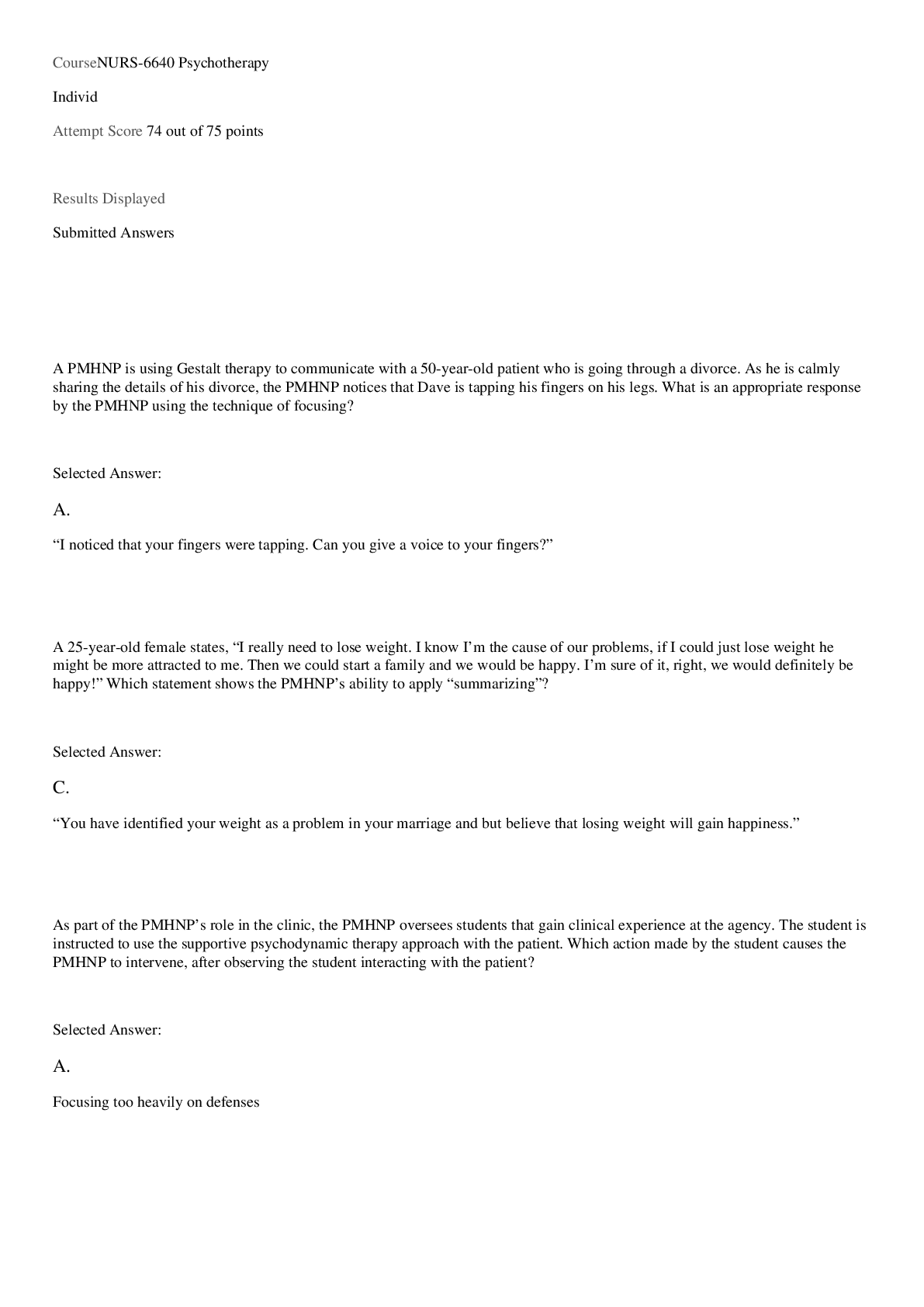
NURS 6640 MIDTERM AND FINAL EXAM – PACKAGE
NURS 6640 MIDTERM AND FINAL EXAM – PACKAGE/NURS 6640 MIDTERM AND FINAL EXAM – PACKAGE
By Bestnurse 3 years ago
$60.5
11

NURS 6640 FINAL EXAM PACKAGE, 06 SETS (QUESTION AND ANSWERS)
NURS 6640 FINAL EXAM PACKAGE, 06 SETS (QUESTION AND ANSWERS)/NURS 6640 FINAL EXAM PACKAGE, 06 SETS (QUESTION AND ANSWERS)/NURS 6640 FINAL EXAM PACKAGE, 06 SETS (QUESTION AND ANSWERS)
By Bestnurse 3 years ago
$50.5
6
Reviews( 0 )
Document information
Connected school, study & course
About the document
Uploaded On
May 12, 2021
Number of pages
30
Written in
Additional information
This document has been written for:
Uploaded
May 12, 2021
Downloads
0
Views
99


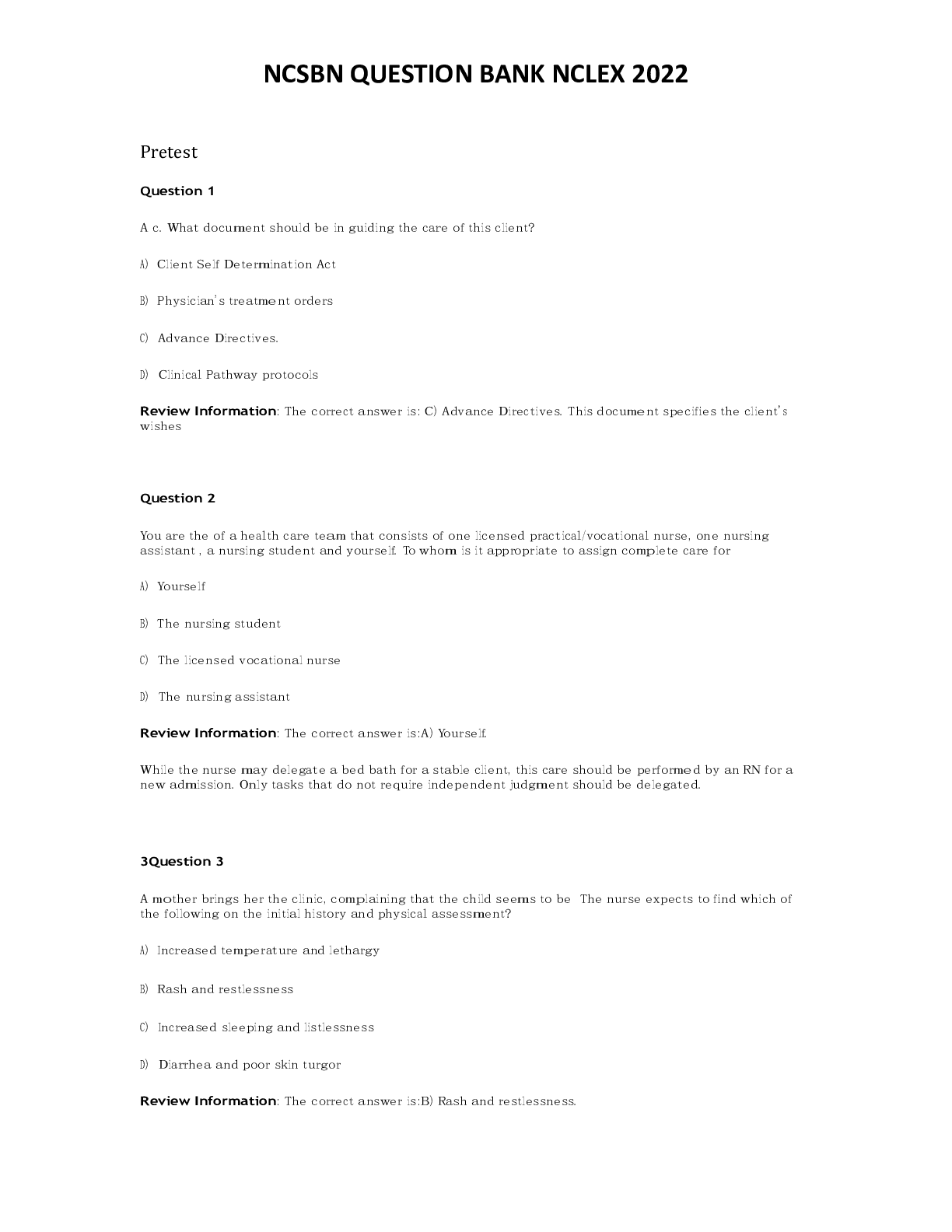

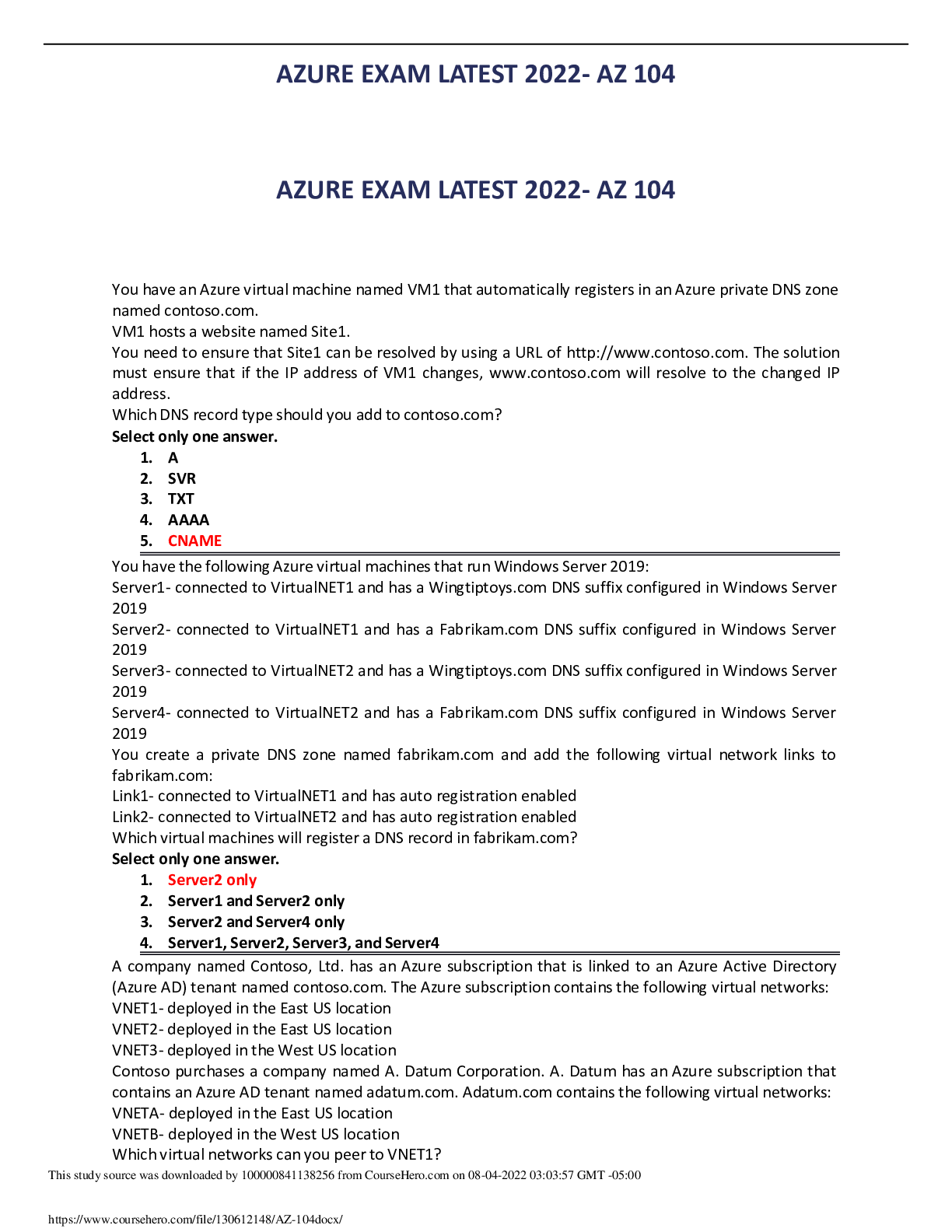
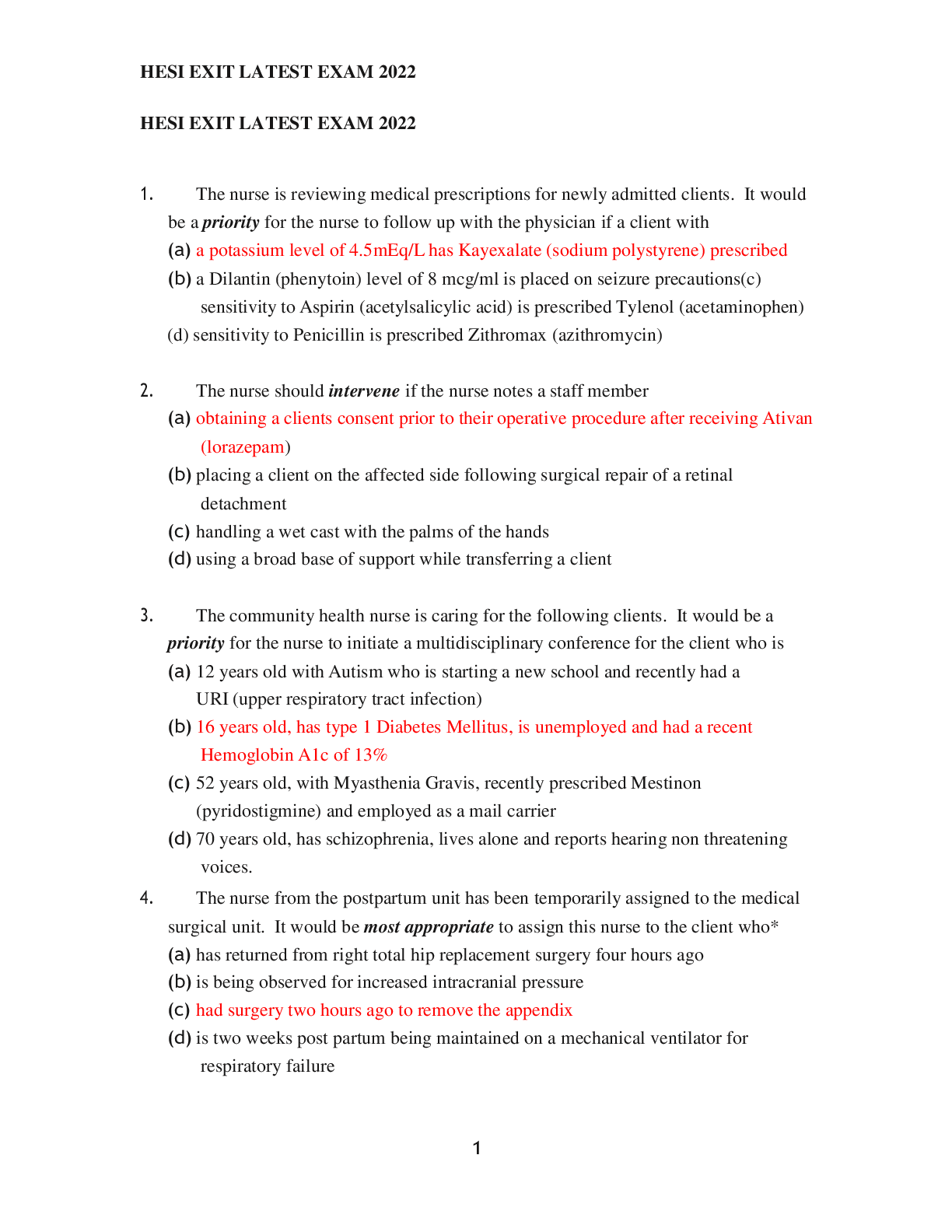
 17.png)

.png)

